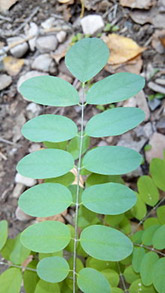 Family: Fabaceae (Leguminosae) – Pea and Bean Family
Family: Fabaceae (Leguminosae) – Pea and Bean Family
Status: Common to abundant in Ohio and throughout the United States.
Some people might confuse the Black Locust with the Honey Locust which is a very common tree in The Woods. The Black Locust tree can be distinguished from the Honey Locust because it only has pinnate leaves and the individual leaflets are larger than those of the Honey Locust.
Also, Black Locust trees do not have the distinctive large branched thorns of the Honey Locust, but instead have a short pair of sharp spines or prickles at the base of each leaf.
In the springtime, the Black Locust will produce large clusters of fragrant white flowers. The tree produces legume fruits in early autumn. Although the legumes cannot be eaten by wildlife, the trees can provide cover from open areas and species such as bobwhite quail will eat the seeds. The tree grows in almost all soils as long as the soil is not overly wet, and does not tolerate shade very well, preferring to grow in full sunlight.
